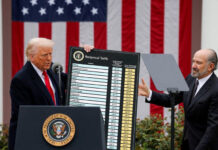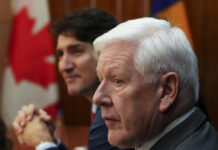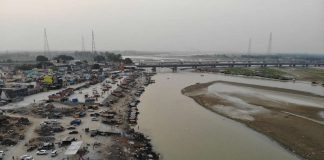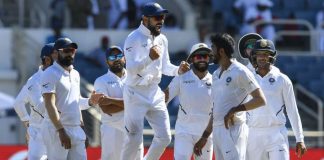APRIL 29, 2018

Korea Summit Press Pool via AP North Korean leader Kim Jong Un is seen at Peace House of the border village of Panmunjom in the Demilitarized Zone, South Korea, Friday, April 27, 2018.
SEOUL, South Korea — North Korea’s leader, Kim Jong-un, told President Moon Jae-in of South Korea when they met that he would abandon his nuclear weapons if the United States would agree to formally end the Korean War and promise that it would not invade his country, a South Korean government spokesman said Sunday.
In a faith-building gesture ahead of a summit meeting with President Trump, Mr. Kim also said he would invite experts and journalists from South Korea and the United States to watch the shutdown next month of his country’s only known underground nuclear test site.
The comments by Mr. Kim were made on Friday when the leaders of the two Koreas met at Panmunjom, a village on their shared border, the spokesman, Yoon Young-chan, said on Sunday, providing additional details of the meeting.
“I know the Americans are inherently disposed against us, but when they talk with us, they will see that I am not the kind of person who would shoot nuclear weapons to the south, over the Pacific or at the United States,” Mr. Kim told Mr. Moon, according to Mr. Yoon’s account of the meeting.
It was another dramatically conciliatory statement by Mr. Kim, whose country threatened to do exactly those things during the height of nuclear tensions last year.
Mr. Yoon revealed more details of the daylong talks between Mr. Kim and Mr. Moon as many have expressed skepticism about the friendly gestures made by the North Korean leader, and whether they would turn out to be empty promises aimed at lifting sanctions on his isolated country.
On Friday, Mr. Kim and Mr. Moon signed a joint declaration recognizing “a nuclear-free Korean Peninsula” and “complete denuclearization” as a common goal of the two Koreas. But during the summit events, some of which were broadcast live around the world, Mr. Kim never publicly renounced his nuclear weapons.
Even in the additional details released on Sunday by South Korean officials, Mr. Kim appeared to hedge his bet, indicating that denuclearizing his country could be a long process that required multiple rounds of negotiations and steps to build trust. But he laid out a vague idea of what his impoverished country would demand in return for giving up its nuclear weapons.
”If we meet often and build trust with the United States and if an end to the war and nonaggression are promised, why would we live in difficulty with nuclear weapons?” Mr. Kim was quoted as saying by South Korean officials.
Mr. Moon has already informed Mr. Trump about the contents of the meeting, briefing him during a call on Saturday. According to Mr. Moon’s office, he told the American president that Mr. Kim said he and Mr. Trump could “get along well,” to which Mr. Trump responded that he “looked forward” to their meeting.
On Sunday, Mr. Moon also spoke with the Japanese prime minister, Shinzo Abe, to relay Mr. Kim’s willingness to also open dialogue with Tokyo, which has also felt threatened by the North’s nuclear weapons and missile development.
The peacemaking comments have been a dramatic turnaround for Mr. Kim, who drove the peninsula close to the brink of war last year by launching a series of missile and nuclear tests.
He suddenly switched to diplomatic overtures this year, extending an offer to meet Mr. Trump, which the American president surprisingly accepted. A week ago, Mr. Kim announced an end to all nuclear and long-range missile tests and the closure of the nuclear test site in mountainous Punggye-ri in northeast North Korea.
On Friday, he became the first North Korean leader to step into South Korean territory when he met with Mr. Moon inside the heavily fortified Demilitarized Zone dividing the two countries.
In the meeting, Mr. Kim and Mr. Moon also agreed to start talks this year with Washington to negotiate a peace treaty to formally end the 1950-53 Korean War, one of the key security guarantees that the North has long demanded.
But North Korea has so far offered no timeline for dismantling its nuclear weapons and facilities. Nor has it clarified how it defines a “nuclear-free Korean Peninsula,” and especially whether that means a withdrawal or significant reconfiguration of American troops based in South Korea, as it has demanded before.
Even before Mr. Moon met with Mr. Kim, South Korean officials said any joint statement was bound to be vague on the terms of denuclearization because Mr. Kim would try to settle critical issues directly with Washington.
If Mr. Kim intends to win a peace treaty, diplomatic recognition and billions of dollars in economic aid from Washington and its allies, as South Korean officials hope he does, trading away his nuclear arsenal is his biggest bargaining chip to extract those rewards. He cannot reveal his hand too soon, South Korean officials said.
Skeptics fear that Mr. Kim does not really intend to give up his nuclear weapons, and is merely trying to soften his image, escape sanctions and make it more difficult for Mr. Trump to continue to threaten military action. But South Korean officials argue that Mr. Kim is willing to bargain away his nuclear weapons in return for ending hostilities and getting Washington’s help to improve his country’s economy.
North Korea’s promise to invite outsiders to Punggye-ri reflected “Mr. Kim’s determination to actively and pre-emptively deal with the process of verifying denuclearization,” Mr. Yoon said.
However, skeptics point to 2008, when North Korea invited foreign journalists to watch it blow up a cooling tower of a nuclear reactor that it had agreed to scrap under a deal with Washington. It later restarted that reactor when the deal broke down.
Similarly, some analysts have played down the significance of North Korea’s offer to shut down the Punggye-ri test site. They said that after six tests, all conducted in deep tunnels, the place had caved in and become too unstable for another test.
On Friday, Mr. Kim offered a rebuttal to these criticisms, Mr. Yoon said Sunday.
”They will see when they visit there that there are two more tunnels bigger than the tunnels used and that they are intact,” he quoted Mr. Kim as saying.
In another conciliatory gesture toward South Korea, Mr. Kim made his own pledge of nonaggression toward the South.
“I am determined not to repeat the painful history of the Korean War. As the same nation living on the same land, we should never shed blood again,” he told Mr. Moon, according to Mr. Yoon. “I will give you my word that there will never be a use of force.”
Mr. Kim even vowed to readjust his country’s clock to match the time zone in South Korea.
In 2015, North Korea created its own time zone — “Pyongyang time” — and set its clocks 30 minutes behind those of South Korea, Japan and other neighbors. That has since created confusion among officials from both Koreas when they tried to schedule their meetings, such as the summit meeting on Friday.
“When I was sitting in the waiting room, I saw two clocks on the wall, one of the Seoul time and the other of the Pyongyang time, and I felt bad about it,” Mr. Kim was quoted as telling Mr. Moon. “Why don’t we reunify our clocks first?”
Courtesy/Source: NY Times








































































































